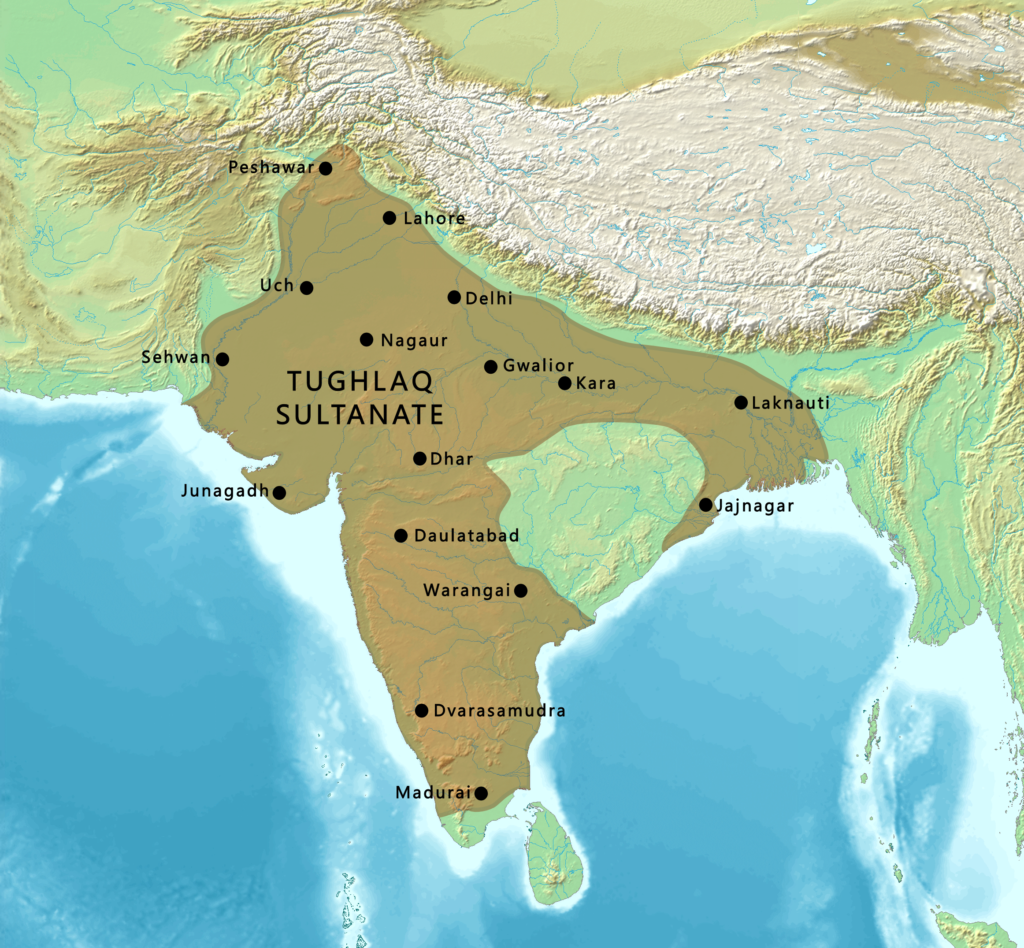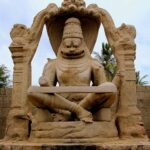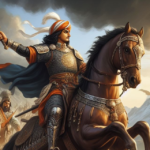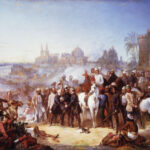The Tughlaq dynasty ruled over the Delhi Sultanate in India from 1320 to 1413 AD. It was founded by Ghazi Malik, who took the name Ghiyas-ud-din Tughlaq after becoming the Sultan. Ghiyas-ud-din Tughlaq attempted to conquer the Deccan region in southern India but faced many challenges, including a rebellion by his own son. His successor, Muhammad bin Tughlaq, also tried to expand the empire but faced many setbacks, including a failed attempt to move the capital from Delhi to Daulatabad in the Deccan.
Despite their military failures, the Tughlaq sultans were also known for their patronage of art, literature, and architecture. Muhammad bin Tughlaq was a great patron of learning and is said to have established several colleges and libraries throughout his kingdom.
The Tughlaq dynasty declined after the death of Firuz Shah Tughlaq in 1388, and the Delhi Sultanate was eventually overthrown by the Timurid invader, Timur, in 1398.
Giyasuddin Tuglaq
- Ghiyasuddin Tughlaq was the founder of the Tughlaq dynasty and ruled as the Sultan of Delhi from 1320 to 1325.
- He was originally a governor under the Khilji dynasty, but he seized the throne after the death of the last Khilji Sultan.
- Ghiyasuddin Tughlaq was a military commander and fought several successful campaigns in the north.
- He also attempted to expand his empire into the Deccan region of southern India but faced several rebellions and uprisings.
- Ghiyasuddin Tughlaq was known for his administrative reforms, including the introduction of a postal system, a new currency, and a department of agriculture.
- He also tried to reform the revenue system by introducing a new land measurement system.
- Ghiyasuddin Tughlaq was a patron of art and architecture, and several important buildings were constructed during his reign, including the Tughlaqabad Fort in Delhi.
- He was a strict ruler and known for his harsh punishments, which earned him the nickname “the butcher.”
- Ghiyasuddin Tughlaq died in 1325, and was succeeded by his son Muhammad bin Tughlaq.
- Despite his military and administrative achievements, Ghiyasuddin Tughlaq is often criticized for his harshness and for starting a trend of incompetent successors in the Tughlaq dynasty.
Muhammad-bin-Tuglaq
- Muhammad bin Tughlaq was the second Sultan of the Tughlaq dynasty, ruling from 1325 to 1351.
- He was the son of Ghiyasuddin Tughlaq, the founder of the Tughlaq dynasty.
- Muhammad bin Tughlaq was a scholar, philosopher, and poet. He had a deep interest in learning and was known for his patronage of the arts and literature.
- He was also interested in science and technology and is said to have attempted to invent a flying machine.
- Muhammad bin Tughlaq was an ambitious ruler who attempted to expand his empire into the Deccan region of southern India.
- He also tried to centralize the administration of the Delhi Sultanate by introducing several administrative reforms.
- Muhammad bin Tughlaq’s most controversial decision was to move the capital of the Delhi Sultanate from Delhi to Daulatabad in the Deccan region. This decision proved to be a disaster and was eventually reversed.
- He was known for his experimentation with the currency system, which led to a significant economic crisis.
- Muhammad bin Tughlaq is also known for his attempt to introduce a token currency made of brass and copper, which failed.
- During his reign, Muhammad bin Tughlaq introduced several agricultural reforms, including the construction of canals and the planting of new crops.
- He was also known for his interest in medicine and is said to have established several hospitals and dispensaries.
- Muhammad bin Tughlaq faced several rebellions and uprisings during his reign, and his attempts to suppress them were often harsh.
- He was known for his cruelty and is said to have ordered the execution of thousands of people in Delhi.
- Muhammad bin Tughlaq was a patron of the arts and literature and is said to have established several colleges and libraries throughout his kingdom.
- He also commissioned several important buildings, including the Adina Mosque in Bengal and the massive fort at Jalore.
- Muhammad bin Tughlaq was a patron of the Sufi mystic Nizamuddin Auliya and is said to have visited him frequently.
- He was an excellent linguist and was known to be fluent in several languages, including Persian, Arabic, Turkish, and Sanskrit.
- Muhammad bin Tughlaq was known for his interest in astronomy and is said to have built an observatory in Delhi.
- His reign saw several calamities, including famines and floods, which led to widespread suffering and loss of life.
- Despite his many achievements, Muhammad bin Tughlaq is often criticized for his controversial decisions and for the decline of the Tughlaq dynasty.
Feroz Shah Tuglaq
- Feroz Shah Tughlaq was the third Sultan of the Tughlaq dynasty, ruling over the Delhi Sultanate from 1351 to 1388.
- He was the grandson of Ghiyasuddin Tughlaq and the successor of Muhammad bin Tughlaq.
- Feroz Shah Tughlaq is known for his patronage of art, literature, and architecture. He was an avid builder and constructed several new buildings, such as the Feroz Shah Kotla Fort and the Jama Masjid in Delhi.
- He built new towns of Hissar, Firozpur, Fatehabad, Jaunpur and Firozabad( his Capital)
- He also undertook several repair and restoration projects of historical monuments, such as the Qutub Minar and the Red Fort in Delhi.
- During his reign two Ashokan pillars, one from Topara in Ambala and the other from Meerut were brought.
- Feroz Shah Tughlaq was a patron of learning and was known to be well-versed in several languages, including Persian, Arabic, and Sanskrit.
- He introduced several administrative reforms, including the establishment of a department of agriculture and the introduction of a new system of revenue collection.
- Feroz Shah Tughlaq was known for his efforts to improve the lives of his subjects, particularly in the areas of agriculture, irrigation, and public works.
- He was also known for his religious tolerance and patronage of Sufi saints.
- Feroz Shah Tughlaq was a prolific author and wrote several books, including the Fatawa-i-Jahandari, a treatise on agriculture, and the Tarikh-i-Firoz Shahi, a history of his reign.
- Feroz Shah Tuglaq also made Iqtadari system hereditary and imposed new taxes like Kharaj(land tax equal to one-tenth of the producer) and Zakat and Khams (one tenth of the booty captured in war).
- He made Jizya a separate tax and he imposed this tax upon the Brahmans for the first time in the history of Sultanate.
- He introduced the following coins- Aadha, Bhikh, Shasgani and Hasthragani.
- He died in 1388 and was succeeded by his cousin, Ghiyasuddin Tughlaq II.
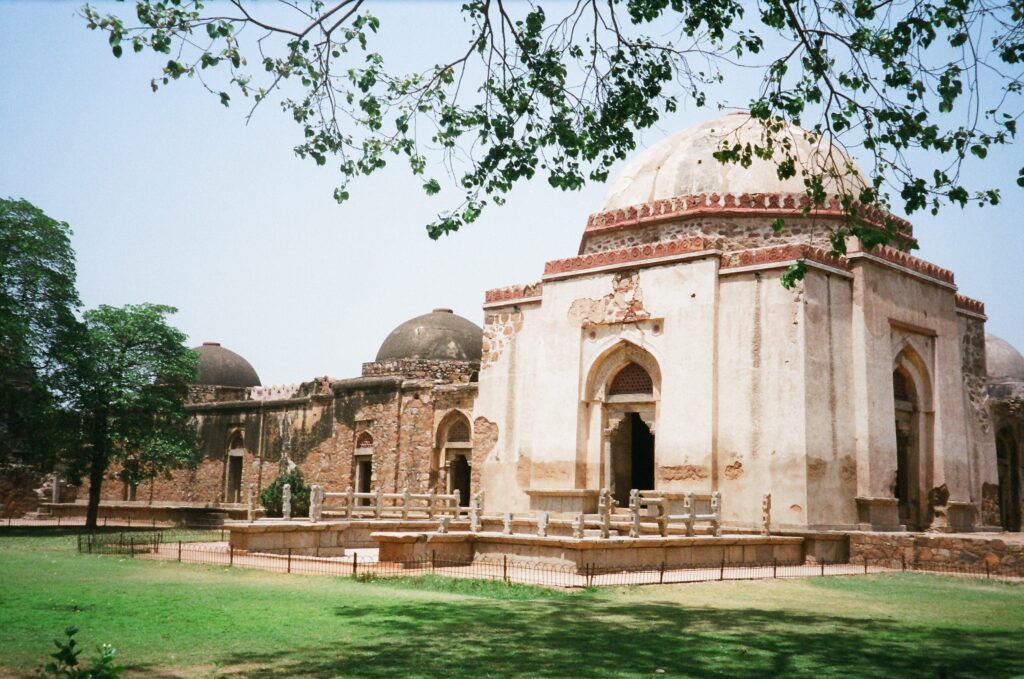
Downfall of Tuglaq Dynasty
The Tughlaq dynasty, which ruled over the Delhi Sultanate from 1320 to 1413, eventually faced its downfall due to a combination of factors. Here are some important points on the downfall of the Tughlaq dynasty:
- The policies of Muhammad bin Tughlaq, who ruled from 1325 to 1351, are believed to have played a significant role in the decline of the dynasty. His failed military campaigns, harsh taxation policies, and experiments with currency caused widespread discontent among the people.
- The Tughlaq dynasty also faced several rebellions and uprisings during its later years. The nobles and provincial governors became increasingly independent and started to challenge the central authority.
- The Mongol invasion of India in the late 14th century weakened the Delhi Sultanate, and the Tughlaq dynasty was unable to effectively resist the invaders.
- The regional kingdoms of Vijayanagara and Bahmani emerged in the south, which challenged the authority of the Delhi Sultanate and further weakened the Tughlaq dynasty.
- The constant power struggles within the Tughlaq dynasty itself, with frequent coups and assassinations, further weakened the central authority and stability of the dynasty.
- The last ruler of the Tughlaq dynasty, Nasiruddin Mahmud, faced several rebellions and invasions from neighboring kingdoms, and he was eventually defeated and killed by the Sayyid dynasty in 1413.
- The Vijayanagara Empire (1336–1646)
- Akbar the Great (1542-1605)
- The Khilji Dynasty: A Powerful Era of Turbulence and Transformation 1290-1320
- The Great Maurya Dynasty (322 BCE – 184 BCE)
Multiple Choice Question on Tuglaq Dynasty
- Who was the founder of the Tughlaq dynasty?
a) Ghiyasuddin Tughlaq
b) Muhammad bin Tughlaq
c) Feroz Shah Tughlaq
d) Alauddin Khilji Answer: a) Ghiyasuddin Tughlaq - Which city did Ghiyasuddin Tughlaq choose as his capital?
a) Delhi
b) Agra
c) Lahore
d) Jaunpur Answer: c) Lahore - Who was the most famous ruler of the Tughlaq dynasty?
a) Ghiyasuddin Tughlaq
b) Muhammad bin Tughlaq
c) Feroz Shah Tughlaq
d) Alauddin Khilji Answer: b) Muhammad bin Tughlaq - Muhammad bin Tughlaq shifted his capital from Delhi to which city?
a) Jaunpur
b) Daulatabad
c) Lahore
d) Agra Answer: b) Daulatabad - What was the reason behind Muhammad bin Tughlaq’s decision to shift the capital?
a) To strengthen his control over the Deccan
b) To escape the Mongol invasions
c) To establish trade routes with Europe
d) To build a more magnificent city Answer: a) To strengthen his control over the Deccan - Muhammad bin Tughlaq introduced which currency in his empire?
a) Gold coins
b) Silver coins
c) Copper coins
d) Brass coins Answer: c) Copper coins - Which of the following policies was implemented by Muhammad bin Tughlaq?
a) Forced conversions to Islam
b) Religious tolerance
c) Land reforms
d) Caste-based reservations Answer: c) Land reforms - Which expedition led by Muhammad bin Tughlaq resulted in a disastrous outcome?
a) Conquest of Bengal
b) Conquest of Tibet
c) Conquest of Maldives
d) Conquest of Persia Answer: c) Conquest of Maldives - Muhammad bin Tughlaq attempted to introduce which administrative reform?
a) Village councils
b) District courts
c) Postal system
d) Provincial assemblies Answer: d) Provincial assemblies - Who succeeded Muhammad bin Tughlaq as the ruler of the Tughlaq dynasty?
a) Feroz Shah Tughlaq
b) Alauddin Khilji
c) Iltutmish
d) Sikandar Lodi Answer: a) Feroz Shah Tughlaq - Feroz Shah Tughlaq is known for constructing which iconic structure in Delhi?
a) Red Fort
b) Jama Masjid
c) Qutub Minar
d) Purana Qila Answer: d) Purana Qila - Feroz Shah Tughlaq established a new city named:
a) Ferozabad
b) Ferozepur
c) Ferozeshahar
d) Ferozeshah Kotla Answer: d) Ferozeshah Kotla
- Feroz Shah Tughlaq established a new city named:
a) Ferozabad
b) Ferozepur
c) Ferozeshahar
d) Ferozeshah Kotla Answer: d) Ferozeshah Kotla - Feroz Shah Tughlaq introduced a new system of irrigation known as:
a) Bandobast system
b) Barani system
c) Diwan-i-Khairat system
d) Shamsi system Answer: a) Bandobast system - Which of the following architectural marvels was constructed during Feroz Shah Tughlaq’s reign?
a) Taj Mahal
b) Fatehpur Sikri
c) Hauz Khas Complex
d) Hawa Mahal Answer: c) Hauz Khas Complex - Feroz Shah Tughlaq revived which ancient city and made it his capital for some time?
a) Ujjain
b) Taxila
c) Kannauj
d) Prayagraj Answer: b) Taxila - Who among the following rulers of the Tughlaq dynasty was known for his patronage of Sufism?
a) Ghiyasuddin Tughlaq
b) Muhammad bin Tughlaq
c) Feroz Shah Tughlaq
d) Ghiyath al-Din Tughluq Shah II Answer: c) Feroz Shah Tughlaq - Feroz Shah Tughlaq constructed several canals for irrigation purposes. Which canal was named after his sister?
a) Yamuna Canal
b) Ganga Canal
c) Sutlej Canal
d) Nahar-i-Firoz Answer: d) Nahar-i-Firoz - Who among the following rulers of the Tughlaq dynasty issued the first known regular currency in the Indian subcontinent?
a) Ghiyasuddin Tughlaq
b) Muhammad bin Tughlaq
c) Feroz Shah Tughlaq
d) Nasir-ud-Din Mahmud Answer: b) Muhammad bin Tughlaq - Which Sultan of the Tughlaq dynasty faced severe revolts and challenges from various regional governors and nobles?
a) Ghiyasuddin Tughlaq
b) Muhammad bin Tughlaq
c) Feroz Shah Tughlaq
d) Nasir-ud-Din Mahmud Answer: b) Muhammad bin Tughlaq - Feroz Shah Tughlaq was succeeded by his grandson, who was the last ruler of the Tughlaq dynasty. What was his name?
a) Mahmud Tughlaq
b) Nasir-ud-Din Mahmud
c) Ghiyath al-Din Tughluq Shah II
d) Mohammad Tughlaq Answer: c) Ghiyath al-Din Tughluq Shah II - The Tughlaq dynasty came to an end with the invasion of Delhi by which dynasty?
a) Khilji dynasty
b) Sayyid dynasty
c) Lodi dynasty
d) Mughal dynasty Answer: b) Sayyid dynasty
- The Sayyid dynasty, which ended the Tughlaq dynasty, was established by:
a) Khizr Khan
b) Bahlul Khan Lodi
c) Ibrahim Lodi
d) Sher Shah Suri Answer: a) Khizr Khan - Which major event led to the decline of the Tughlaq dynasty?
a) Mongol invasions
b) Revolts by regional governors
c) Economic instability
d) Foreign invasions by Timur Answer: b) Revolts by regional governors - Overall, the Tughlaq dynasty is remembered for:
a) Its military conquests
b) Economic prosperity
c) Administrative experiments
d) Promotion of arts and culture Answer: c) Administrative experiments
